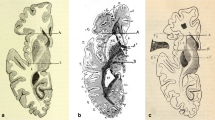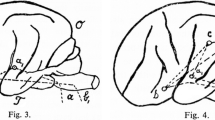Abstract
In this paper, a historical overview of the interpretation of conduction aphasia is initially presented. It is emphasized that the name conduction aphasia was proposed by Wernicke and was interpreted as a disconnection between the temporal and frontal brain language areas; this interpretation was re-taken by Geschwind, attributing the arcuate fasciculus the main role in speech repetition disturbances and resulting in the so-called Wernicke-Geschwind model of language. With the introduction of contemporary neuroimaging techniques, this interpretation of conduction aphasia as a disconnection syndrome due to an impairment of the arcuate fasciculus has been challenged. It has been disclosed that the arcuate fasciculus does not really connect Wernicke’s and Broca’s areas, but Wernicke’s and motor/premotor frontal areas. Furthermore, conduction aphasia can be found in cases of cortical damage without subcortical extension. It is concluded that conduction aphasia remains a controversial topic not only from the theoretic point of view, but also from the understanding of its neurologic foundations.
Similar content being viewed by others
References
Papers of particular interest, published recently, have been highlighted as: • Of importance •• Of major importance
Benson DF, Ardila A: Conduction aphasia: a syndrome of language network disruption. In Handbook of Speech and Language Disorders. Edited by Kirshner H. New York: Mercel Dekker; 1994:149–164.
Benson DF, Ardila A: Aphasia: A Clinical Perspective. New York: Oxford University Press; 1996.
Goldstein K: Language and Language Disturbances. New York: Grune & Stratton; 1948.
Kertesz A: Aphasia and Associated Disorders. New York: Grune and Stratton; 1979.
Kertesz A: Aphasia. In Handbook of Clinical Neurology, vol 45: Clinical Neuropsychology. Edited by Frederiks JA. Amsterdam: Elsevier; 1985:287–332.
Kohn S: Conduction Aphasia. Mahwah, NJ: Erlbaum; 1992.
Bartha L, Benke T: Acute conduction aphasia: an analysis of 20 cases. Brain Lang 2003, 85:93–108.
Wernicke C: Der Aphasiche Symptomen Complex. Breslau: Taschen; 1874.
Luria AR: Basic Problems of Neurolinguistics. The Hague: Mouton; 1976.
Luria AR: Higher Cortical Functions in Man. New York: Basic Books; 1980.
Benson DF, Sheremata WA, Bouchard R, et al.: Conduction aphasia: a clinicopathological study. Arch Neurol 1973, 28:339–346.
Shallice T, Warrington EK: Auditory short term memory impairment and conduction aphasia. Brain Lang 1977, 4:479–491.
Caplan DM, Vanier M, Baker C: A case study of reproduction conduction aphasia I: word production. Cogn Neuropsychol 1986, 3:99–128.
Axer H, von Keyserlingk AG, Berks G, von Keyserlingk DG: Supra- and infrasylvian conduction aphasia. Brain Lang 2001, 76:317–331.
Caramazza A, Basili AG, Koller JJ, Berndt RS: An investigation of repetition and language processing in a case of conduction aphasia. Brain Lang 1981, 14:235–271.
Hickok G: Speech perception, conductive aphasia, and the functional neuroanatomy of language. In Language and the Brain: Representation and Processing. Edited by Grodzinsky Y, Shapiro LP, Swinney D. New York: Academic Press; 2000:87–101.
Ardila A, Rosselli ML: Repetition in aphasia. J Neuroling 1992, 7:1–11.
Geschwind N: Disconnection syndromes in animals and man. Brain 1965, 88:237–294.
Geldmacher DS, Quigg M, Elias WJ: MR tractography depicting damage to the arcuate fasciculus in a patient with conduction aphasia. Neurology 2007, 69:321.
Yamada K, Nagakane Y, Mizuno T, et al.: MR tractography depicting damage to the arcuate fasciculus in a patient with conduction aphasia. Neurology 2007, 68:789–790.
•• Catani M, Jones DK, Ffytche DH: Perisylvian language networks of the human brain. Ann Neurol 2005, 57:8–16.
Catani M, Ffytche DH: The rises and falls of disconnection syndromes. Brain 2005, 128(Pt 10):2224–2239.
Xia Y, Turken U, Whitfield-Gabrieli SL, Gabrieli JD: Knowledge-based classification of neuronal fibers in entire brain. Med Image Comput Comput Assist Interv 2005, 8:205–212.
Catani M, Thiebaut de Schotten M: A diffusion tensor imaging tractography atlas for virtual in vivo dissections. Cortex 2008, 44:1105–1132.
• Catani M, Mesulam M: The arcuate fasciculus and the disconnection theme in language and aphasia: history and current state. Cortex 2008, 44:953–961. This paper reviews the 19th century roots of the connectionist approach to aphasia and describes emerging imaging technologies based on diffusion tensor imaging.
Makris N, Kennedy DN, McInerney S, et al.: Segmentation of subcomponents within the superior longitudinal fascicle in humans: a quantitative, in vivo, DT-MRI study. Cereb Cortex 2005, 15:854–869.
• Duffau H: The anatomo-functional connectivity of language revisited. New insights provided by electrostimulation and tractography. Neuropsychologia 2008, 46:927–934. This article discusses the role of the white bundles thought to be essential for language. An integrative view of connectivity is proposed, interpreting language as the final product of the well-synchronized functioning of parallel distributed cortico-subcortical networks.
Tanabe H, Sawada T, Inoue N, et al.: Conduction aphasia and arcuate fasciculus. Acta Neurol Scand 1987, 76:422–427.
Anderson JM, Gilmore R, Roper S, et al.: Conduction aphasia and the arcuate fasciculus: a reexamination of the Wernicke-Geschwind model. Brain Lang 1999, 70:1–12.
Quigg M, Geldmacher DS, Elias WJ: Conduction aphasia as a function of the dominant posterior perisylvian cortex. Report of two cases. J Neurosurg 2006, 104:845–848.
Kreisler A, Godefroy O, Delmaire C, et al.: The anatomy of aphasia revisited. Neurology 2000, 54:1117–1123.
Shuren JE, Schefft BK, Yeh HS, et al.: Repetition and the arcuate fasciculus. J Neurol 1995, 242:596–598.
Zhang Y, Wang C, Zhao X, et al.: Diffusion tensor imaging depicting damage to the arcuate fasciculus in patients with conduction aphasia: a study of the Wernicke-Geschwind model. Neurol Res 2009 Oct 12 [Epub ahead of print].
•• Bernal B, Ardila A: The role of the arcuate fasciculus in conduction aphasia. Brain 2009, 132(Pt 9):2309–2316. The authors propose a new language network model emphasizing that the arcuate fasciculus connects posterior brain areas with Broca’s area via a relay station in the premotor/motor areas.
Matsumoto R, Nair DR, LaPresto E, et al.: Functional connectivity in the human language system: a cortico-cortical evoked potential study. Brain 2004, 127:2316–2330.
•• Bernal B, Altman N: The connectivity of the superior longitudinal fasciculus: a tractography DTI study. Magn Reson Imaging 2010, 28:217–225. The authors of this paper found that the superior longitudinal fasciculus connects the posterior language areas to the precentral gyrus and only marginally in some cases to the canonical Broca’s area.
• Ardila A: A proposed reinterpretation and reclassification of aphasic syndromes. Aphasiology 2010, 24:363–394. A new classification of aphasic syndromes is proposed and a distinction between primary (or “central”) aphasias (Wernicke’s aphasia—three subtypes—and Broca’s aphasia), secondary (or “peripheral”) aphasias (conduction aphasia and supplementary motor area aphasia), and dysexecutive aphasia (extrasylvian—transcortical—motor aphasia) is introduced.
Harnish SM, Neils-Strunjas J, Lamy M, Eliassen JC: Use of fMRI in the study of chronic aphasia recovery after therapy: a case study. Top Stroke Rehabil 2008, 15:468–483.
Robin DA, Jacks A, Hageman C, et al.: Visuomotor tracking abilities of speakers with apraxia of speech or conduction aphasia. Brain Lang 2008, 106:98–106.
Kimura N, Kumamoto T, Hanaoka T, et al.: Corticobasal degeneration presenting with progressive conduction aphasia. J Neurol Sci 2008, 269:163–168.
Disclosure
No potential conflict of interest relevant to this article was reported.
Author information
Authors and Affiliations
Corresponding author
Rights and permissions
About this article
Cite this article
Ardila, A. A Review of Conduction Aphasia. Curr Neurol Neurosci Rep 10, 499–503 (2010). https://doi.org/10.1007/s11910-010-0142-2
Published:
Issue Date:
DOI: https://doi.org/10.1007/s11910-010-0142-2




